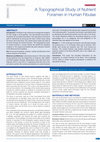Papers by Dr.Prashant Moolya
International journal of anatomy radiology and surgery, 2022
Inclusion criteria: The cadavers available in the Department of Anatomy irrespective of age and s... more Inclusion criteria: The cadavers available in the Department of Anatomy irrespective of age and sex were used for the study. Exclusion criteria: Damaged anatomy of the axillary region due to fibrosis of tissues or trauma were excluded.

International journal of anatomy and research, Oct 10, 2018
Brachial plexus has been the subject of various studies as it is an important nerve plexus at the... more Brachial plexus has been the subject of various studies as it is an important nerve plexus at the junction of neck and upper limb. For procedures like neurotisation, nerve grafting and shoulder joint surgery by anterior approach, knowledge of brachial plexus and its variation will be helpful to prevent any iatrogenic trauma to the nerves. Aim of this study was to find out about the variation in the branching pattern of the cords of brachial plexus. Methods: The present study was carried out by dissection of 120 (60 right and 60 left) upper limbs in 60 embalmed cadavers that were available in the department of Anatomy of Seth G. S. Medical College and KEM hospital Mumbai. Result: Variations were encountered in the branching pattern of lateral and posterior cord, while medial cord branches did not show any variation. Knowledge pertaining to the variation in the branching pattern of the cords of brachial plexus will guide the operating surgeon to prevent any iatrogenic trauma.

International journal of anatomy radiology and surgery, 2021
The fibula is very well known amongst the surgeons for their usage in bone grafting. The vascular... more The fibula is very well known amongst the surgeons for their usage in bone grafting. The vascularised bone graft is necessary for successful procedure. The vasculature of the bone graft is maintained by procuring the intact nutrient artery along the donor site of the bone. The nutrient artery enters the shaft of the bone through the nutrient foramen. The topographical study of nutrient foramen in human fibulae will benefit the operating surgeons in the surgical procedures like open reduction fracture of the fibula and bone grafting. Aim: To record the position, location, number and direction of the nutrient foramen of the fibula. A descriptive study on 100 human dried fibulae obtained from the Department of Anatomy, Seth GSMC and KEM hospital, Mumbai, Maharashtra, India were done from February 2013 to July 2013. A magnifying hand lens and a thin stiff wire to confirm the number and direction of nutrient foramen were used. The lengths of the fibulae were measured and divided into three equal parts. The position and location were determined by identifying the anatomical position and the side of the fibula. The simple statistical method by calculating frequency (n) and percentages (%) in all categories and sub-categories of the collected data was applied to the study. Results: In 17.24% of fibulae the foramen was directed towards the growing end. In 7% of fibulae, there was no foramen, 23% fibulae were having two foramina, and 70% were having one foramen. The nutrient foramen was located maximally on the posterior surface of the fibula (84.48%) and in the middle onethird (81.03%). This study has provided information on the topography of nutrient foramen of the fibula. This knowledge will be useful in certain surgical procedures to preserve the vascularity of fibula.

JOURNAL OF CLINICAL AND DIAGNOSTIC RESEARCH
Introduction: Renal vascular anatomy is well known in the literature about its variations. The da... more Introduction: Renal vascular anatomy is well known in the literature about its variations. The data of cadaveric study performed by different authors in different populations is suggestive of variable nature of existence of renal artery variations. A thorough knowledge of accessory renal arteries is important for planning and performing endovascular, laparoscopic, urological and radiological procedures and renal transplants. Aim: To study the variations of renal arteries in cadavers and to compare it based on laterality, sex and symmetry in Nashik region, Maharashtra, India. Materials and Methods: The present cross-sectional study was conducted at SMBT Institute of Medical Sciences and Research Center, Dhamangaon, Nashik, Maharashtra, India, from May 2019 to June 2020 during routine abdominal dissection for medical undergraduate students. Total 25 cadavers (21 males and four females) were dissected to expose kidneys along with its arteries. The morphological variations (early branch...

INTERNATIONAL JOURNAL OF ANATOMY RADIOLOGY AND SURGERY
Introduction: The Axillary Arch Muscle (AAM), is a rare anomalous finding in the axilla also know... more Introduction: The Axillary Arch Muscle (AAM), is a rare anomalous finding in the axilla also known as langer’s muscle. In the literature, it is explained as a narrow muscular slip that extends from the latissimus dorsi to the pectoralis major. Variations of this muscular anomaly have been observed. The abduction and external rotation like simulation of the arm in the cadaver suggest the possibility of neurovascular compression by the AAM. The AAM causing compression is considered an etiology of thoracic outlet syndrome by some authors. The symptoms generated by neural or vascular compression can be differentiated clinically. The purpose of this article was to compare the potential role of AAM in causing neural or vascular compression and discussion with the clinical studies which showed varied results. Aim: To find out the possible anatomy of axillary arch muscle and its relation with neurovascular structures. Materials and Methods: The descriptive cadaveric study was conducted in t...

INTERNATIONAL JOURNAL OF ANATOMY RADIOLOGY AND SURGERY, 2021
Introduction: The fibula is very well known amongst the surgeons for their usage in bone grafting... more Introduction: The fibula is very well known amongst the surgeons for their usage in bone grafting. The vascularised bone graft is necessary for successful procedure. The vasculature of the bone graft is maintained by procuring the intact nutrient artery along the donor site of the bone. The nutrient artery enters the shaft of the bone through the nutrient foramen. The topographical study of nutrient foramen in human fibulae will benefit the operating surgeons in the surgical procedures like open reduction fracture of the fibula and bone grafting. Aim: To record the position, location, number and direction of the nutrient foramen of the fibula. Materials and Methods: A descriptive study on 100 human dried fibulae obtained from the Department of Anatomy, Seth GSMC and KEM hospital, Mumbai, Maharashtra, India were done from February 2013 to July 2013. A magnifying hand lens and a thin stiff wire to confirm the number and direction of nutrient foramen were used. The lengths of the fibul...

International Journal of Anatomy and Research, 2018
Brachial plexus has been the subject of various studies as it is an important nerve plexus at the... more Brachial plexus has been the subject of various studies as it is an important nerve plexus at the junction of neck and upper limb. For procedures like neurotisation, nerve grafting and shoulder joint surgery by anterior approach, knowledge of brachial plexus and its variation will be helpful to prevent any iatrogenic trauma to the nerves. Aim of this study was to find out about the variation in the branching pattern of the cords of brachial plexus. Methods: The present study was carried out by dissection of 120 (60 right and 60 left) upper limbs in 60 embalmed cadavers that were available in the department of Anatomy of Seth G. S. Medical College and KEM hospital Mumbai. Result: Variations were encountered in the branching pattern of lateral and posterior cord, while medial cord branches did not show any variation. Knowledge pertaining to the variation in the branching pattern of the cords of brachial plexus will guide the operating surgeon to prevent any iatrogenic trauma.
International Journal of Anatomy and Research, 2016
Introduction: 'Brachial plexus' which literally means 'arm braid' (brachium=arm; plexus=braid) is... more Introduction: 'Brachial plexus' which literally means 'arm braid' (brachium=arm; plexus=braid) is an important content of axilla. Knowledge about relationship of cords and branches of brachial plexus to axillary artery is mandatory for the anaesthetists for giving brachial plexus block by axillary approach, for the surgeons who operate in the axillary region and for the radiologists for interventional therapy.











Uploads
Papers by Dr.Prashant Moolya